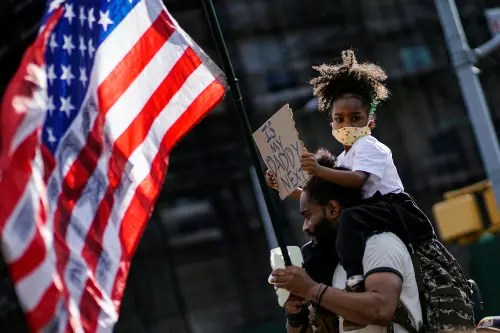Anagha Komaragiri made significant contributions to this post.
The racial wealth gap has been a widely acknowledged phenomenon in the academic and policy realms for years, and has become an important issue in the run-up to the 2020 election. The difference in the assets and debts of white and black families in the U.S. has been a persistent and pervasive problem. Nationally, white college graduates have more than seven times the wealth of black college graduates and four times the wealth of Latinx graduates, and white single parents have approximately twice the wealth of two-parent black and Latinx households.
On June 3, Governance Studies at Brookings, along with Contexts Magazine, convened an expert panel to discuss the causes and consequences of the racial wealth gap. The panelists also discussed potential policy solutions to address the issue.
Camille Busette, senior fellow at Brookings and director of the Race, Prosperity, and Inclusion Initiative, moderated the discussion, which featured: Alexandra Killewald, professor of sociology at Harvard University; Rashawn Ray, associate professor of sociology at the University of Maryland and co-editor of Contexts Magazine; Thomas Shapiro, professor of law and social policy at Brandeis University; and Tonia Wellons, vice president of community investment at the Greater Washington Community Foundation.
Overview of the racial wealth gap
The discussion began with each panelist providing some insight into the issue–both how it emerged over time, and how materializes today. Killewald noted that while the wealth gap is the product of a variety of historical and contemporary processes, encompassing differences in access to public resources, quality of education, and the housing market. “There’s no one mechanism that we can point to that is responsible for the racial wealth gap,” she said.
Ray introduced the racial wealth gap in the context of the middle class. In his research on social class identification, Ray found that even when African Americans had the same level of education, income and occupational prestige as white Americans, they were significantly less likely to identify as middle-class. Ray attributed this to the experience of social class that transcends the apparent value of wealth, emphasizing the existing barriers that African Americans face today when it comes to homeownership and entrepreneurship.
Wealth inequality: Numbers versus narrative
Shapiro brought up a comparative figure to depict the magnitude of the wealth gap: The median average white family in the U.S. has approximately $171,000 in net wealth, while the median African American family has approximately $17,000. “That’s a dime in wealth for every dollar of wealth that that typical white family has,” he noted.
“They says that ‘wealth begets wealth,’ but unfortunately poverty begets poverty as well.”@tmshapiro highlights how the #RacialWealthGap has actually been expanding over time. pic.twitter.com/lSyZGzQVcD
— Brookings Governance (@BrookingsGov) June 3, 2019
He further alluded to research that has controlled for unequal social origins or differences in education, jobs, income, or family structure, but still leaves half of the racial wealth gap intact. Shapiro argued that in addition to our understanding of the racial wealth gap as it exists today, the narrative of inequality and racial justice is essential to analyze.
Policies, past and present
Panelists then discussed previous policies that have been designed to alleviate the wealth gap. Wellons argued that affirmative action was an essential step in making race consciousness a major element of policymaking around higher education and federal employment. “I think it goes to show that positive steps toward achieving race-conscious policies and decisionmaking can have and have had a very positive impact on moving … black people, especially, into the middle class,” she said.
Shapiro, meanwhile, mentioned that virtually all the Democratic presidential candidates have introduced trademark policies that they argue could potentially help alleviate wealth inequality, from those targeting the housing market or student debt to baby bonds. “That mantra, that beginning of public consciousness about the need to close the racial wealth gap, has permeated at least the rhetorical level of a certain Democratic base,” Shapiro argued.
A path forward
Of the many potential solutions that have been introduced to close the gap, a few especially stood out to the panelists. Ray suggested numerous policies that could be enacted to potential success: guaranteed income, baby bonds, loan forgiveness, down payment assistance and reparations.
5 policy ideas that may help close the #RacialWealthGap via @SociologistRay:
1️⃣ Universal basic income
2️⃣ Student loan forgiveness
3️⃣ Mortgage assistance programs
4️⃣ Baby bonds
5️⃣ Reparations— Brookings Governance (@BrookingsGov) June 3, 2019
Killewald noted that class-based policies that disproportionately benefit people of color can be significant, but are not specifically geared toward race and racialized, contemporary institutions. In addition to such programs, she argued that policies involving contemporary housing discrimination and the improvement of school systems are also significant, race-based approaches.
Public opinion and policy
Shapiro argued that community organizing, electorates, and visibility are all elements that can hold power, and in turn influence the policy sphere. However, policy can still be enacted as a tool to impact public opinion. “Let’s identify where palpable, everyday harm is being created in an inequitable way, and let’s reverse that,” he said. He further argued that the current tax code and unequal distribution of subsidies for homeowners serve as major areas for democratic reform.
Ray noted that when it comes to the issue of reparations, public opinion can be a key factor in shaping policy. Ray argued that a reparations commission can help social scientists and policymakers reach a consensus on the meaning of reparations and how they can be enacted, and that this public consensus is key in enacting policies toward equity.
When asked which policy he or she would pursue if advising a Democratic presidential candidate, each panelist had a distinct answer. Shapiro advocated for Elizabeth Warren’s student debt cancellation plan; Killewald mentioned a reparations commission; Ray brought up the issue of loan forgiveness; and Wellons noted both a truth and reconciliation commission and individual payments as reparations.
Lightning round question: solve #racialwealthgap in one policy:@tmshapiro – student loan debt cancellation
A. Killewald – reparations commission@SociologistRay – loan forgiveness @ToniaWellons – reparations AND truth in reconciliation— Chloe Bovia (@chloeindc) June 3, 2019
While a variety of policies have been presented as potential solutions, the discussion emphasized their role in addressing both the historical and contemporary causes of the racial wealth gap. As solutions to both racial and economic inequality come to the forefront among presidential candidates, the racial wealth gap will remain a critical issue of debate for policymakers in the foreseeable future.





Commentary
A conversation about the racial wealth gap—and how to address it
June 18, 2019